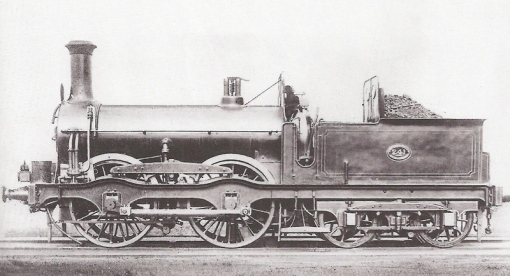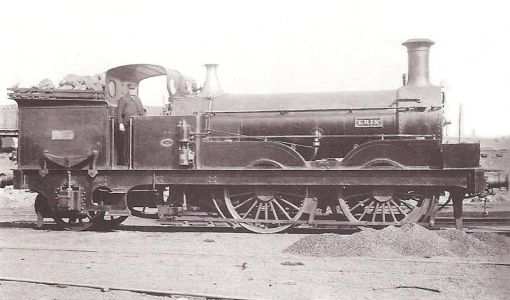June 2010
Monthly Archive
June 15, 2010
Posted by Adrian under
Structures
[2] Comments

Unfortunately life has crashed in on things of late which has led to the dearth in updates, and further posts over the next couple of weeks will be sporadic. I had planned to continue waffling on about the companies from south of the Thames working the EWL, but due to time constraints, that’s temporarily on the backburner. So, to maintain some kind of momentum…
Although it might be argued that much of the East End was home to the poorest of the poor, it may be surprising to find that wretched housing existed even in areas such as Westminster, and I’m quite at ease with transplanting some of these buildings into Basilica Fields. Great to model – just look at all that fabulous detail – but I wouldn’t like to have lived there!
Grubb Street, seen here in 1906, was just off Horseferry Road, and sat in the shadow of the pomp and wealth of the Houses of Parliament and Westminster Abbey. Charles Booth, in his survey published in 1889, suggested the immediate area was ‘poor’, with a moderate family earning as little as 18 – 21 shillings per week.
Today, Horseferry Road has changed somewhat:
June 4, 2010

The South Eastern Railway, long time rival of the LC&DR in Kent, was the first of the two companies to arrive in London – in 1836 it shared the London Bridge terminus with the London & Croydon and London & Greenwich companies. The SER added three further London termini to it’s bow; Bricklayers Arms in 1844, Charring Cross in 1864 and Cannon Street in 1866, however it had no direct access to the Widened Lines until 1878 when the link between Metropolitan Junction and St. Pauls (Blackfriars) was opened on the London Bridge – Waterloo line. The SER was less active in cross-river services than its rival the LC&DR, but nevertheless, within a month the company was providing trains to Enfield and Ally Pally on the Great Northern. The company’s first locomotives to be fitted with condensing apparatus were Cudworth’s 235 Class of 0-4-4 Well Tanks of 1866, slightly odd looking locos with very long bunkers, but the locos were painfully under-powered for Widened Lines duties, struggling on on the steep gradient connecting line at Metropolitan Junction. Until the situation could be remedied, the current Locomotive Superintendent, James Stirling (brother of Patrick) approached and bought three of the well-proven Beyer Peacock 4-4-0Ts from the Metropolitan Railway which were used exclusively on cross-London services to GNR destinations until Stirling’s own design could be implemented (more of which anon) in 1881.
Meanwhile, from the 1st April 1880, the SER began running sixteen trains daily from Addiscombe (Croydon) via New Cross and the East London Railway (ELR), under the Thames to Liverpool Street. In 1882, the SER became one of the co-lessees of the ELR, and from 3rd March 1884 the company cut back the service from Addiscombe – St. Mary’s, until withdrawing it completely on 30th September of that year. In 1865, despite not providing any passenger services over the ELR, the SER took over responsibility for maintaining the line.
With the opening of the New Thames Tunnel in the early 90s, the SER took the opportunity to provide a circle within the Circle service out from New Cross and back again via Deptford Road on the ELR, the New Thames Tunnel, Limehouse and Basilica Fields on the Extended Widened Lines, Bishopsgate and St. Pauls on the Widened Lines, and finally round to London Bridge and back to New Cross.
The photo is one of Cudworth’s 235 class, no.241, and Stirling’s domeless boilers were fitted during 1881-3. It was the first front-coupled bogie tank design built for an English railway, and both the driving wheels and bogie axles were connected by compensating beams. Four of the class (but not no.241) were fitted with condensing apparatus in June 1878 for services running between Woolwich Arsenal via Metropolitan Junction and the Widened Lines to Enfield, Muswell Hill and Alexandra Palace on the GNR. The Beyer Peacock 4-4-0Ts relieved them of these duties in 1880, and the class were instead transferred to East London Railway duties. These locos were then relieved from that line when Stirling’s Q class were released to traffic in 1882.
This class won’t be represented on Basilica Fields; all bar two were gone by 1890, one of which went that year, and the other lingered at Ashford Works until 1893. However, they are an interesting locomotive to highlight, not least in terms of historical importance, and must have looked extraordinarily quaint, even during their last years of service.
June 2, 2010

Continuing on from my earlier post , I thought it might be an idea to show how the Extended Circle & Widened Lines, and the East London Railway Extension with the new Thames Tunnel all fits into the geography of East London.
If you’ve read the earlier post you will know how the Extended Lines branch off from the Inner Circle just after Bishopsgate (Liverpool Street), and here you can see the Extended Circle and Widened Lines pushing east as far as Bow before heading south towards the river where there was a junction for the New Thames Tunnel at Limehouse. The Extended Circle and Extended Widened Lines finally headed west, past the docks to Mark Lane, while the new tunnel took the line under the Thames and the Surrey Commercial Docks to Deptford Road, where the line rejoined the ELR to New Cross. For clarity I’ve only marked the Basilica Fields stations on the map (both the GER and Metropolitan ones), but there are other stations on the Metropolitan line which I’ll describe later. For the same reason I’ve omitted the goods depots which will be covered in subsequent posts.
As an aside, welcome to new readers. Unique hits almost doubled yesterday, with almost 100 different visitors which I find staggering.
June 1, 2010

With the imminent opening of Ludgate Hill terminus, and the projected link with the Widened Lines at West Street, by August 1864 it was obvious to the board of the LC&CR that a more powerful class of locomotive than the Second Sondes was needed for the cross-London trains, and following much discussion, Martley’s design for a larger 2-4-0T was put out to tender. Neilson & Co.returned with the lowest price, but following consultation with the Locomotive Superintendent, Neilson & Co. suggested substituting the design for an 0-4-2 well tank, similar to those being supplied by them to Sturrock of the GNR for Widened Lines duties. Sturrock was approached and had no objection to his design being replicated, and so the Chatham was supplied with fourteen of the well tanks. Named after Scottish islands and rivers, the class became known on the Chatham as Scotchmen; they performed their duties well, and remained on Widened Lines turns until the introduction of Kirtley’s A class 0-4-4Ts in the mid-1870s.
Between 1868 and 1871, Patrick Stirling introduced the 126 class 0-4-2WTs replace Sturrock’s tanks on the GNR Widened Lines services. Concurrently, the LC&DR realised the need for more and more powerful locomotives for cross-London trains, and on the advice of Neilson & co., Martley once again approached the Great Northern, and was granted permission to base the new Chatham locos on Stirling’s design. Like the Scotchmen before them, the Large Scotchmen performed well on Widened Lines duties, showing an aptitude for quick acceleration and improved riding qualities at speed over their predecessors. Their Widened Lines duties included sharing the Victoria to Moorgate Street services with the Second Sondes class, as well as services to Wood Green over the Great Northern, to Hendon via the Midland, and City portions of main line trains from Holbourn Viaduct to Herne Hill. At the turn of the century, the class was still employed on the latter, but by now, instead of terminating at Moorgate Street, services from Victoria ran as far as Basilica Fields.
Erin, No.97, was photographed at Longhedge in the early 1890s. The Westinghouse brake was fitted in 1890-1, and iron brake shoes replaced the wooden blocks seen here, from this date. The rounded corners to the lining, just visible under the grime, replaced concave corners from 1892. Both this, and the photo of the Second Sondes shatter Bradley’s assertion in his book that:
Chatham locomotives were among the best groomed and smartest locomotives in the country. Every express passenger engine was thoroughly cleaned daily no matter what the climatic conditions. Many passenger tanks received similar attention…The Locomotive History of the London, Chatham & Dover Railway – D.L. Bradley (RCTS) p.10.
The loco sports the small Neilson works plate, name plate, and a brass ownership plate on the bunker. It has a replacement Kirtley cast chimney, and has been fitted with a rudimentary all-over roof and rear weatherboard.



